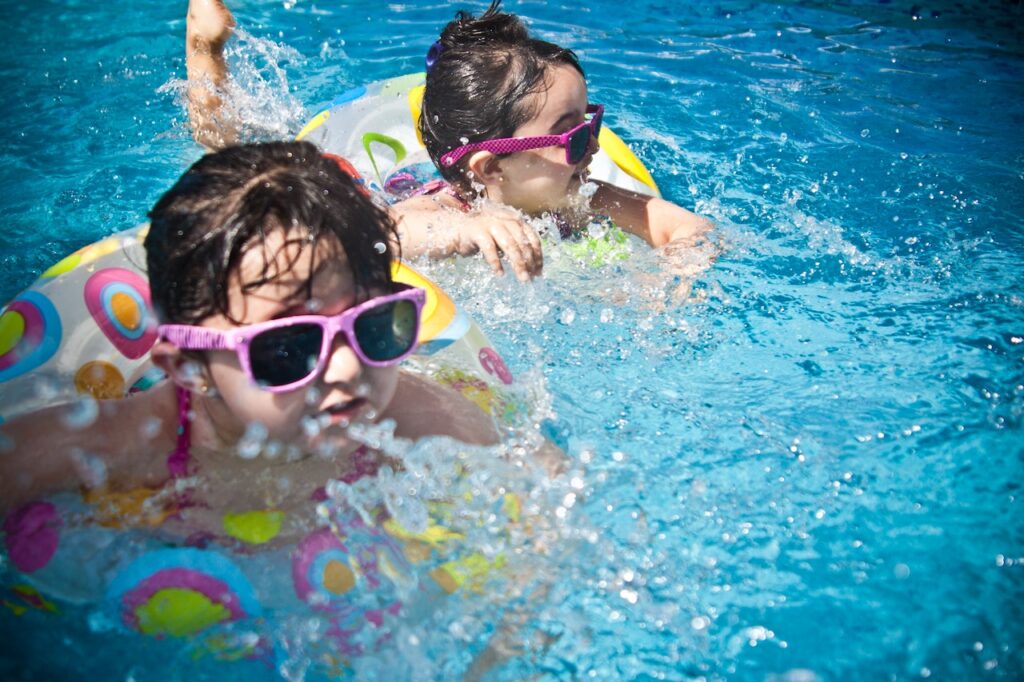The lazy days of summer are just around the corner for Minnesotans. Gone are the snow, wind, and ice, and now it’s time to don your swimsuits and hit the water. Whether your family spends these warm days at a community pool or beachside at Lake Ann, make loads of happy memories when you practice safety first. With our guide, you’ll learn the do’s and don’ts of water play with children, so you can relax and splash the season away in Chanhassen.
Invest in Swimming Lessons

2 Girl’s Swimming During Daytime by Juan Salamanca is licensed with Pexels License
The American Academy of Pediatrics recommends starting your kids off with swim lessons at just 12 months of age. These lessons are imperative for children 4 and under because they help significantly reduce a child’s risk of drowning. Little ones are curious; even the most attentive parent has lost sight of a child for a second. Unfortunately, that’s all it takes to slip past a pool gate. Make sure you know a few basic techniques, like treading water and the breaststroke, in case your child needs help.
We believe the best way for your family to learn to swim is with lessons. Kids develop at their own pace, so your child may take to the water quickly or need more coaxing before they feel comfortable in the pool. Either way, this experience could help save a life or even lead to a fun sport your child can enjoy for years to come. Prepare for some fun in the sun and enroll in a local class near home, such as:
- Foss Swim School.
- Life Time Athletic Country Club.
- The City of Chaska.
- Goldfish Swim School.
- AMI Swim School.
Use Floatation Assistance Devices
If there’s ever a question about whether a child should or should not use a floatation assistance device, always play it safe and put it on. Many parents turn to flotation devices for help around water — and that’s terrific. Your first instinct may be to turn to the inflatable arm bands. However, they aren’t enough to prevent accidental drowning.
The most appropriate floatation assistance device for children is a life jacket. Water wings, rafts, and tubes are wonderful toys for playtime but are not the most reliable water safety devices. They can easily slip off your little one’s arms, or the material can puncture and suddenly deflate. According to federal law, all children under 13 must wear an age-appropriate U.S. Coast Guard-approved life jacket when boating. That extra protection also comes in handy anywhere they play in the water, from the beach or pool to a water park.
Watch Kids Around Water
Regardless if your little one is at the top of their swim school class or strapped into the latest and greatest life jacket, there’s no substitute for parental supervision. When kids are near the water, a responsible adult should also be present and attentive. Accidents happen in a flash, and even if there’s a lifeguard on duty, keeping an eye on the kids should be your only concern.
Teach Kids to Ask for Permission
Ensure that children understand the dangers of swimming alone and teach them to always get permission before getting in the water. Backyard pools should always be surrounded by a fence with a self-locking gate. This structure can help children remember to ask mom or dad before jumping in. Other preventative measures include using the Red Cross’s Water Habits Are Learned Early (WHALE) tips to teach kids how to throw a lifesaver to a friend that’s struggling in the water.
Introduce Infant Self-Rescue Swimming Skills
Infant Swimming Resource is an informational aid and database for providers. This revolutionary program teaches children between 6 months and 6 years self-rescue techniques, like floating on their backs until help arrives. Older children learn more advanced techniques, such as safely reaching the pool steps or shoreline on their own. Learning these skills can significantly reduce your child’s risk of drowning and provide little swimmers with the knowledge to save themselves in an emergency.
If you want to sign your child up for an infant self-rescue swimming class, Kelly Sparks in nearby Mound, Minnesota, offers private lessons. However, she isn’t the only local instructor. Check out the ISR instructor website for a complete roster of self-rescue teachers by location.
Encourage Safe Play Near Water
Playing it safe this summer is the best way to relish the season, whether exploring Chanhassen’s many thrilling waterways or wading in a backyard pool. Kids love to run, chase, and play with friends, but most public aquatics facilities discourage this behavior, and for a good reason. It’s too easy to slip on wet surfaces and cause an injury or fall in the water. So remind kids to always walk around the water, enforcing cautious steps.
Not every body of water is deep enough for diving in head first. Plunging into the shallow end is dangerous, and your child can risk serious injuries. Instead, teach kids to go in feet-first or use the stairs and the ladder to enter and exit the pool.
Check Water Temperatures
When warm weather finally arrives in Minnesota, it’s time to beat the heat. But before you let the kids loose, check the water temperature. Frigid water is more than unpleasant, especially if it’s under 64 degrees. The cold can cause muscle spasms that prevent kids from swimming properly while shivering and blue lips can be a sign of hypothermia.
Water that’s too warm can also be problematic. While it may help your child feel more comfortable if it’s too hot, it can cause dizziness. Many families also enjoy running through the sprinkler. This free and convenient activity can make some of the best memories. Just remember that playing with a hose that’s been sitting in the sun can cause burns. The water inside can heat up to 140 degrees Fahrenheit, and you don’t want this beloved pastime to end with a visit to the emergency room.
The expert educators at Crème de la Crème of Chanhassen, Minnesota, put together this list of water safety tips for kids so you and your family can enjoy the cool, refreshing, and worry-free spring and summer. So what do you do to help keep your children safe around water? Let us know so we can add your ideas to our list.
